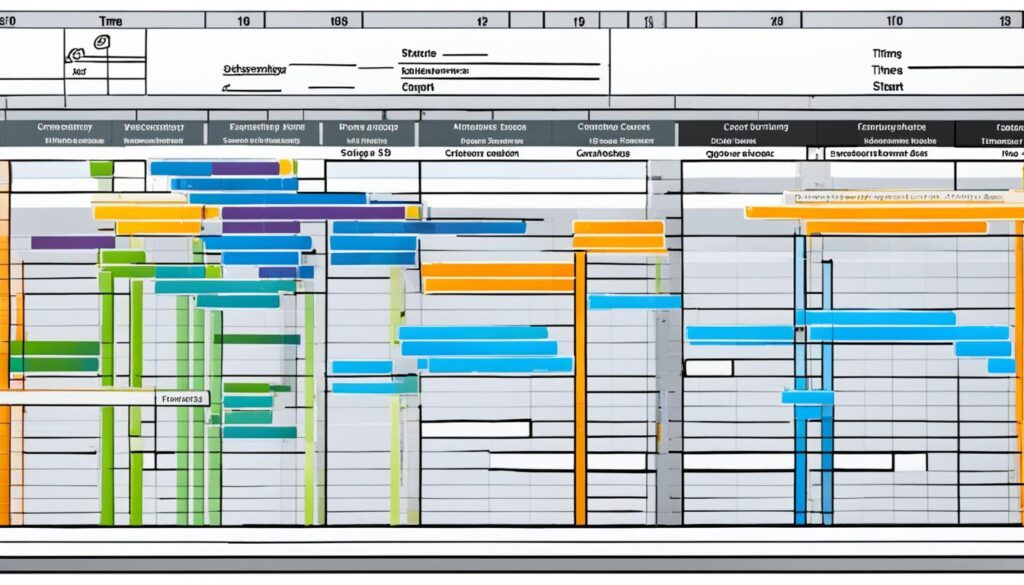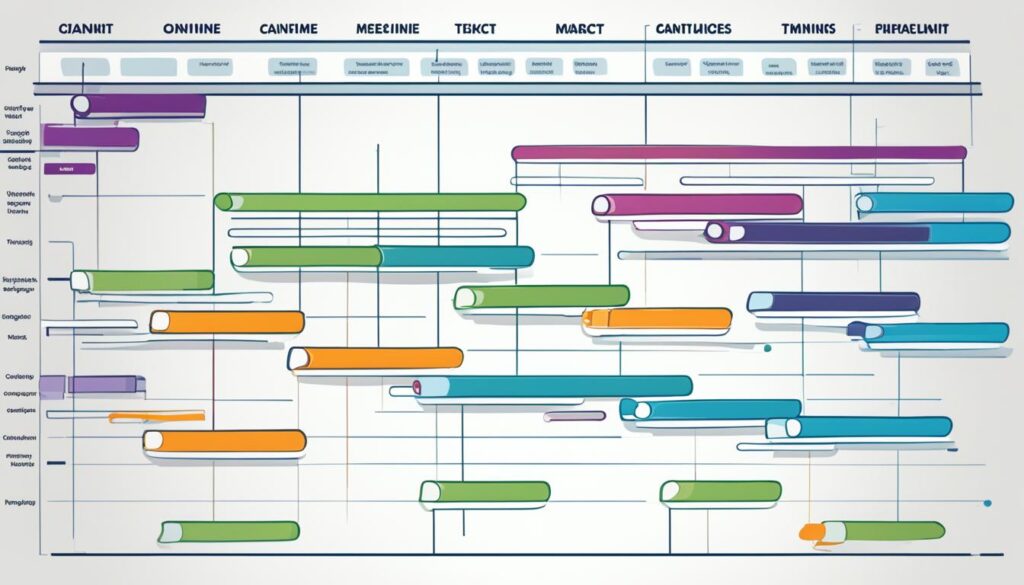Gantt charts are essential tools in the realm of project management, where visual aids are crucial for meticulous planning and execution. Understanding Gantt chart uses in project management has become a fundamental skill for modern managers. Derived from the innovative work of Henry Gantt, these charts offer a bird’s eye view of projects, laying out the sequence and duration of each task with crystal clarity. Merging classical project planning techniques with the dynamic Gantt chart utility, these visual timelines empower teams to track their progress and forecast potential roadblocks.
Today, Gantt charts stand at the forefront of project planning, offering unparalleled insights into resource allocation and time mapping. Their evolution into digital platforms has further amplified their effectiveness, allowing for real-time updates and collaborations across various industries. With Gantt charts, the success of a project is not left to chance; it is meticulously crafted through clear planning and ongoing oversight.
Key Takeaways
- Identify how Gantt chart uses in project management revolutionize tracking and scheduling.
- Recognize the value of Gantt charts in enhancing overall project planning.
- Appreciate the historical development and enduring Gantt chart utility in modern contexts.
- Learn the potential of Gantt charts to improve time management and forecasting in projects.
- Discover the significance of integrating Gantt charts with digital tools for comprehensive project oversight.
Introduction to Gantt Chart and Its Historical Significance in Project Management
The historical significance of the Gantt chart cannot be overstated when it comes to the field of project management. Developed by Henry Gantt, a mechanical engineer and management consultant, the Gantt chart revolutionized how project timelines are constructed and interpreted. This tool bridged the gap between complex project details and straightforward visualization, allowing for enhanced planning and tracking.
Essentially, Gantt charts are a form of bar chart that illustrates a project timeline, providing a graphical representation of a schedule that helps to plan, coordinate, and track specific tasks in a project. It provides a historical snapshot of project management evolution, from rudimentary lists to complex, software-driven engines of efficiency. Below is a brief overview of how Gantt charts have become a cornerstone in project management:
- Early 20th century: Henry Gantt introduces his namesake chart, simplifying project oversight.
- Mid-20th century: Gantt charts are utilized in major global endeavors, proving essential in managing vast, multifaceted projects.
- Late 20th century: With the rise of digital tools, Gantt charts are integrated into software, expanding their capabilities.
- 21st century: Gantt charts are ubiquitous in project management, now a historical artifact of methodology and a tool for complex planning.
Gantt charts have survived and thrived beyond the lifetime of Henry Gantt, embodying more than a century’s worth of project planning acumen. They epitomize a shift in project management, from an era of general oversight to one of meticulous, timeline-driven guidance.
| Period | Influence | Application |
|---|---|---|
| Early adoption | Pioneering project visualization | Industrial manufacturing and warfare logistics |
| Expansion | Global project management standard | Construction, engineering, and software development |
| Digitalization | Increased accessibility and functionality | Widespread across industries with complex endeavors |
The lineage of the Gantt chart mirrors the evolving landscape of project management. Its utility in mapping out a project from inception to completion underscores the timeless need for structure and clarity in managing tasks. Today, the Gantt chart is more than a mere planning apparatus; it’s an indispensable part of project chronology, a testimony of the past, and a beacon for future methodologies in the discipline of organized achievement.
Understanding the Structure of Gantt Charts
The intricacies of Gantt charts lie in their ability to map the multifaceted nature of project tasks and timelines into a coherent visual framework. As a project management tool, Gantt charts excel in providing a composite image of project progression, from inception to completion.
Deciphering the Gantt Chart Grid
An essential component of the structure of Gantt charts is the grid. It forms the backbone of project tracking, housing detailed information about individual tasks such as task names, owners, and priority levels. The Gantt chart grid encapsulates the project’s scope by outlining every task that must be accomplished, enabling managers and teams to maintain a clear understanding of responsibilities and task sequencing.

Interpreting the Gantt Chart Timeline
Alongside the grid, the timeline is fundamental in conveying the temporal aspects of project tasks. This horizontal representation stretches across the chart, illustrating how tasks are distributed over time, reflecting dependencies and the current status of progress. This aspect facilitates task scheduling, offering a temporal perspective that aids in the recognition of critical paths and potential scheduling conflicts.
Pivotal Components of Effective Gantt Charts
To rise above being merely an illustrative tool, effective Gantt charts amalgamate several pivotal components that enhance their utility in project management. These components include strategically placed milestones to signify key points within the project, explicit outlines of resource requirements, and precise cost estimates—all crucial for comprehensive project planning and control. These components allow project stakeholders to identify, assess, and reallocate resources as needed, ensuring a fluid transition between project phases and maintaining efficient momentum towards the ultimate goal.
What Gantt chart is used for?
Delving into the realm of project management tools reveals the versatile applications of Gantt charts, which stand as pillars for visual representation and organizational efficiency. These charts are pivotal for a host of activities that shape the success of any project by offering clarity and precision in planning and execution.

Visualizing Project Timelines and Dependencies
As a cornerstone in presenting a project timeline, Gantt charts provide a comprehensive overview of project phases with their visually intuitive bars. Project managers rely on these charts to identify and illustrate key dependencies, allowing for a proactive approach to bottleneck prevention and progress tracking. This visual roadmap thereby becomes indispensable in guiding teams through complex sequences of tasks toward a successful project conclusion.
Improving Task Scheduling and Time Management
Time is a non-renewable resource, especially in project management. Here, Gantt charts facilitate impeccable task scheduling, serving as a dynamic ledger of time allocation. By permitting real-time updates to task durations and their interdependencies, they become an invaluable asset for time management, ensuring that projects maintain momentum and stakeholders remain informed of schedule shifts.
Facilitating Resource Allocation and Deadlines Management
Allocating resources with foresight and precision underpins the strength of any project framework. Gantt charts rise to the occasion by providing a bird’s-eye view of resource distribution across tasks, which is critical for resource allocation. Additionally, these charts are instrumental in deadlines management, by clearly demarcating the end points of task phases and contributing to an environment where milestones are consistently met.
| Phase | Task | Start Date | End Date | Resources | Status |
|---|---|---|---|---|---|
| Initiation | Project Kickoff | 01/04/2023 | 07/04/2023 | Team A, Meeting Room 1 | Completed |
| Planning | Requirement Analysis | 08/04/2023 | 20/04/2023 | Team B, Analysts | In Progress |
| Execution | Software Development | 21/04/2023 | 15/06/2023 | Team C, Dev Suite 3 | Upcoming |
| Closure | Final Review | 16/06/2023 | 30/06/2023 | Team D, Quality Assurance | Upcoming |
Applying Gantt Charts in Various Industries
The versatility of Gantt charts allows them to be instrumental across a range of fields, effectively addressing the unique project management needs of different sectors. From aiding in complex construction projects to enhancing software development cycles, the adaptability of Gantt charts demonstrates their universal value.
Gantt Charts Streamlining Complex Construction Projects
In the realm of construction projects, Gantt charts play a vital role in simplifying the complexity and scale of such endeavors. By clearly visualizing phase milestones and resource allocations, these charts facilitate an efficient manufacturing process and ensure project managers stay on top of demanding timelines and budget constraints.
Software Development and Agile Planning with Gantt Charts
For software development teams, Gantt charts are pivotal in implementing Agile planning methodologies. These dynamic visual tools enable teams to plot sprint timelines and track feature development through transparent project roadmaps, effectively bridging the gap between Agile’s flexibility and timeline management.
Manufacturing and Production: Beyond Construction
Transitioning Gantt charts usage beyond construction, the sophisticated framework of these charts ensures precision in the manufacturing process. By forecasting production schedules and monitoring workflow efficiencies, Gantt charts empower manufacturers to maintain a competitive edge in product development and delivery.
The strategic use of Gantt charts for project portfolio management cannot be overstated. Their capacity to monitor multiple projects concurrently ensures maximal project alignment, delivering an overarching view of an organization’s initiatives which is crucial for prioritizing resources and achieving strategic goals.
Drafting a Gantt Chart: Steps and Tools for Successful Creation
The intricacies of project management necessitate the use of efficient tools that simplify complex information. Gantt chart software has become a cornerstone in creating visual plans that are both informative and user-friendly. By implementing the right project management tools, one can seamlessly transition from a cluttered whiteboard to a digital masterpiece of timing and coordination.
Selecting the Right Gantt Chart Software
Choosing the perfect Gantt chart software is a pivotal step in executing project management tasks proficiently. Whether you opt for Gantto with its user-friendly interface or Matchware, renowned for its comprehensive features, the goal is to find a system that aligns with your project requirements. A software’s capability to adapt to your project’s changing needs and the ease of integration with other tools should be the deciding factors. When evaluating Gantt chart software options, it’s important to consider its compatibility with your organization’s existing systems. Additionally, seamless integration with top inventory management software systems can be a game-changer in streamlining project workflows and resource allocation. Ultimately, the right Gantt chart software will empower your team to efficiently track project progress and make informed decisions.
Key Steps in Assembling an Effective Gantt Chart
Creating a Gantt chart involves more than just knowing how to use software; it requires an understanding of project intricacies and a methodical approach to task management. The steps to drafting an effective Gantt chart include identifying project phases, setting verifiable milestones, and defining task dependencies, which facilitate the translation of complex project details into organized, visual representations.
| Project Phase | Key Task | Dependency | Milestone |
|---|---|---|---|
| Initiation | Identify Objectives | Executive Buy-in | Project Charter |
| Planning | Resource Allocation | Project Charter Approval | Detailed Project Plan |
| Execution | Task Roll-out | Resource Availability | Completion of First Phase |
| Closure | Final Reporting | Task Completion | Project Handover |
Transitioning from Traditional to Digital Gantt Charts
Moving from traditional project management tools to advanced Gantt chart software can transform your project management approach. Digital solutions lend unparalleled support in tracking progress with real-time updates and enabling collaboration across different teams. The transition not only augurs well for accurate project tracking but also caters to the growing need for remote project management and workforce flexibility.
With the right approach to creating a Gantt chart, project managers and teams can overcome challenges and stride towards project success with certainty and control.
Conclusion
In the realm of project management, Gantt charts have transcended their historical roots to become crucial elements in contemporary planning and tracking. They empower project managers and teams to visualize complex task dependencies and to orchestrate a seamless flow of activities. These charts are particularly effective in ensuring that project management methodologies are not just theoretical constructs but dynamic systems that react and adapt efficiently to the evolving landscape of project needs.
The utility of Gantt charts to optimize project planning is seen in their ability to simplify the intricate web of project timelines and activities. By doing so, they allow for an optimization that goes beyond simple schedules to encompass resource management and stakeholder communications. The carefully laid out structure serves to demystify project details, enabling all involved parties to track progress and anticipate the requirements of subsequent phases.
Ultimately, the widespread adoption of Gantt charts across various industries is a testament to their versatility and effectiveness. From construction to software development, their role in enhancing project efficiency and achieving successful outcomes cannot be overstated. Task dependencies are made clear, resource allocation becomes more scientific, and project trajectories remain aligned with strategic goals, all owing to the rigorous yet flexible framework provided by Gantt charts. The enduring legacy of these tools is evidenced in the project successes they facilitate, marking a significant milestone in the ongoing evolution of project management practices.







